11 August, 2001
The closing hours of science for the 2001 summer season
Today was our last day of science at Summit. We will spend the next two
days dismantling and packing our gear, reversing the process of the first
few days here. Not unlike the last miles in a marathon, the pace
quickened for science today as everyone tried to complete projects.
Amongst the projects being done by this group of scientists are many of
the pieces of the snow and atmospheric chemistry puzzle. It has been
exciting to see so much interaction and sharing of ideas and resources.
Today was a great climax to many of the projects here. Even in the last
hours of the season new discoveries were made and ideas generated for
even MORE projects. Contributing to the party atmosphere of the day was
the weather, it was as beautiful as its been all summer, we could go
without coats and hats. The day had periods of fog and interesting
clouds, but overall was sunny and festive.
Mary Albert of CRREL ran diffusivity tests to examine how the air moves
through the snow when it is not being drawn by pumps. Jack Dibb of UNH
and Aaron Swanson of UC Irvine ran tests involving spraying sea salt on
the snow to investigate the effects of halogens on the snow - air
chemistry. Markus continued to investigate the effects of removing
ultraviolet light from the snow's surface with a variety of shades. The
Swiss team spent the day moving their equipment from their summer weather
port home into the winter lab space in the greenhouse.
Last night I had the opportunity to spend some time with one of the
scientists who seems to integrate with all of our projects, because
without her data on the physical properties of the snow pack, many of the
models of how the gases move through the snow would be less understood.
This scientist, Mary Albert, is from Hanover, New Hampshire. She has been
in the field of polar science especially ice science for many years. Mary
is one energetic lady. I observed her project involving sampling
sections of snow from a snow pit from 11 pm until after midnight, and she
had been going strong with experiments all day long! I, by the way, was
on my way to bed when word came that Mary was doing something I had asked
to see, so I summoned just a little more energy, and got rewarded with
both intersesting science and a beautiful sunset.
In this experiment, Mary collected samples of snow that she cut like
blocks from the wall of the snow pit. Once the blocks were cut, they
were placed into Tupperware containers and labeled as to their location
in the pit and their orientation. These small blocks of ice will be kept
frozen until they can be analyzed for their crystal structure using image
processing techniques. The chemical which she poured onto the samples,
dimethyl phalate, will serve to lock the crystals into place by becoming
plastic in the open spaces between the crystals. The crystal structure
and density of the crystals in the sample can help scientists to predict
which layers of snow are more permeable to gas transport. Mary has also
been working with Aaron, Jack and Markus conducting tracer gas
experiments. In these experiments, she injects a stable inert gas into
the snow with a probe and then they time how long it takes to reach other
probes in the snow placed at different depths and locations in the upper
layers of the snow. This information helps the scientists understand
where the air that is entering their probes is really coming from. It's
not always what they think is happening! Snow that is dense and hard
blocks the flow of gas. This layer of snow can be caused by wind packing
the crystals or a sun-warmed layer that formed in the summer.
For several seasons, Mary has brought with her a field assistant, Ted
Schultz. This is Ted's second season at Summit. Thanks to Mary and an
apprenticeship program at CRREL, Ted has been travelling to the field for
many years. He was in Antarctica when he was still in High School! Ted
has been here this season as well, but he has primarily been working with
Jack Dibb. Ted will be begining graduate school at the University of
Wisconsin in Madison this fall. Ted will be studying engineering. He
hopes to design a drill that can't be stuck! I think Ted deserves the
prize for the hardest worker at camp this summer. He averaged 4 hours of
sleep a night!! His job was to assist with the analysis of Jack's vapor
samples. He started each day at 7 and finished well after midnight each
night. Ted managed to find time to figure out everyone's musical dilikes
while in the science weatherport and even made us each a souvenir CD.
Tommorrow begins the packing and preparations for our departure on
Tuesday. We will need to dig up and remove most of our scietific gear.
Without a doubt, these last two days will be as action packed as the
rest. I am looking forward to being at home again, but know I will miss
the atmosphere and excitement of Summit camp.
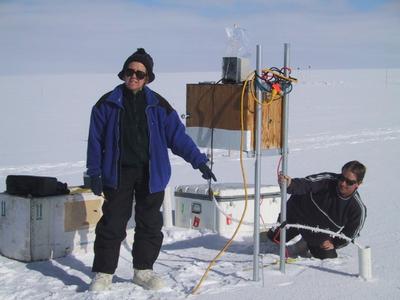
Mary and Aaron set up tracer gas experiments.

Mary collecting snow into tupperware containers for crystal structure analysis.
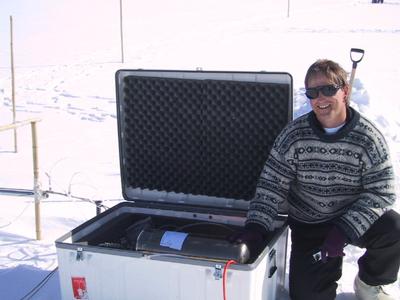
Aaron injecting gases from natural sources like pine trees into the snow.
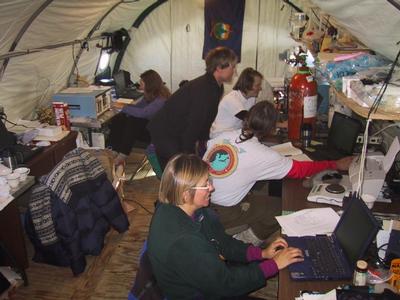
In the weather port, sharing data and ideas. I call it "Ted's World" because he never leaves here and he provides the musical selections.
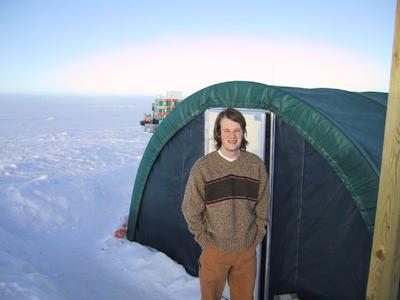
A rare glimpse of Ted in the sunlight.
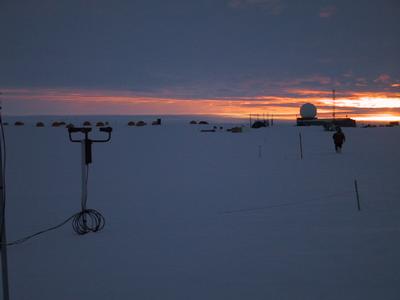
The beautiful sunset at midnight. The sunrise is less than an hour later.
Contact the TEA in the field at
.
If you cannot connect through your browser, copy the
TEA's e-mail address in the "To:" line of
your favorite e-mail package.
|
